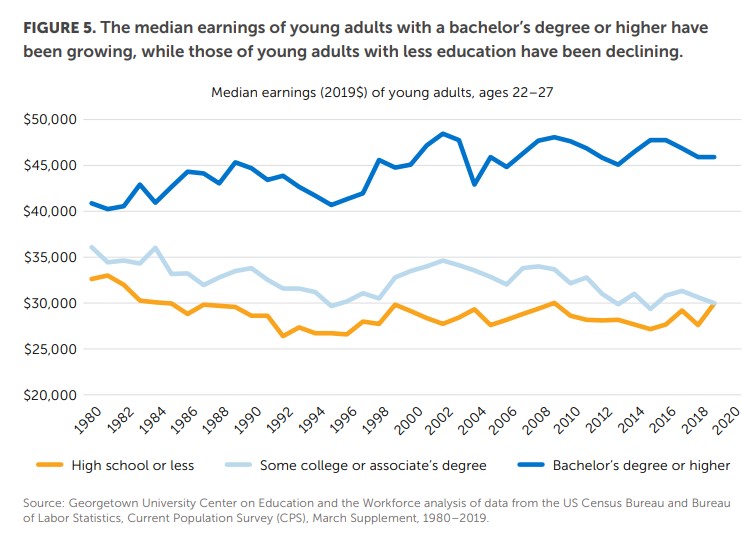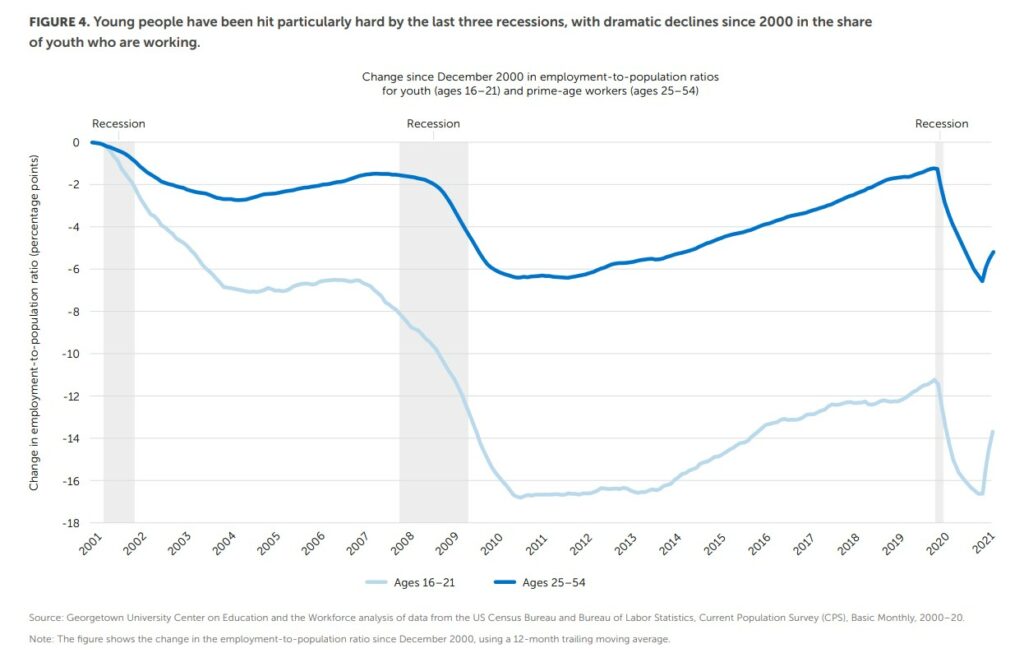The article as it stood was long and enduring. I do not believe many of the readers at AB would complete it. What I did is grab the intro and three graphs to make the point of, we are not doing enough to educate a workforce. Labor that can meet the demands of the future. The nation is failing a large percent of its younger population. through a lack of education and adequate funding to provide for it. Ok, I said it three times. Hopefully, you read it. “Rewrite.” Present Economic Conditions and Post-secondary Education Typical college costs (including tuition and fees, room and board, and allowances for books and supplies, transportation and other personal expenses) range from ,330 for public in-state university students to ,800 for
Topics:
Bill Haskell considers the following as important: Education, politics, US EConomics
This could be interesting, too:
Robert Skidelsky writes Lord Skidelsky to ask His Majesty’s Government what is their policy with regard to the Ukraine war following the new policy of the government of the United States of America.
NewDealdemocrat writes JOLTS revisions from Yesterday’s Report
Joel Eissenberg writes No Invading Allies Act
Ken Melvin writes A Developed Taste
The article as it stood was long and enduring. I do not believe many of the readers at AB would complete it. What I did is grab the intro and three graphs to make the point of, we are not doing enough to educate a workforce. Labor that can meet the demands of the future. The nation is failing a large percent of its younger population. through a lack of education and adequate funding to provide for it.
Ok, I said it three times. Hopefully, you read it. “Rewrite.”
Present Economic Conditions and Post-secondary Education
Typical college costs (including tuition and fees, room and board, and allowances for books and supplies, transportation and other personal expenses) range from $27,330 for public in-state university students to $55,800 for private nonprofit college students (2019). This pricing or cost is still valid in 2024.
Grants and scholarships can relieve some of the financial distress. When taken into account, average net costs for tuition and fees at these kinds of schools are closer to $2,640 and $14,990, respectively.
The pandemic and recent increases in higher education funding may have slowed the speed of rising college costs. A recent report from Georgetown University highlights the growth in the gap between how much young workers make and how much they must pay to earn a college degree over the past several decades. The report, titled “If Not Now, When? The Urgent Need for an All-One-System Approach to Youth Policy,” breaks down seven trends that have made it difficult for workers to transition from education to the workforce since 1980.
The report; “Post secondary education policy fails to keep higher education affordable even as formal education beyond high school has become more essential. Today, two out of three jobs require post-secondary education and training. In the 1970s, three out of four jobs required a high school diploma or less. Yet while young people today need more education than ever to compete in the labor market, a college education is more expensive than in the past.”
By any stretch of reality, the system of educating our young people has failed and is failing people who need and seek a better education.
According to the researchers’ analysis of U.S. Census, Bureau of Labor Statistics and National Center for Education Statistics data for the years 1980 to 2019, college costs have increased by 169% over the past four decades. Earnings for workers between the ages of 22 and 27 have increased by 19%.
This has not changed in 2024 and has worsened.
Postsecondary education policy has failed to keep higher education affordable even as formal education beyond high school has become more essential.
The cognitive competencies in the workforce are generally a part of those with higher levels of education. Today, two out of three jobs require postsecondary education and training. In the past, three of four jobs in the 1970s required a high school diploma or less. Yet while young people today need more education than ever to compete in the labor market, a college education is more expensive than in the past.
Indeed, I would believe the costs of a college education have also outstripped the early-on earning potential. If forbearance or deferment is taken, the interest still accrues. In each case when payments restart, the payments go towards interest first until it is paid off. Long term delays in payment can make a loan difficult to pay.
The costs of higher education have risen rapidly over the past few decades, creating a cost barrier for many young people who wish to pursue a degree or credential (Figure 3). It was also possible to work one’s way through college. Today, college costs are generally too high, young people’s wages too low for working your way through college to be feasible. Consequently, more students have to take on larger amounts of debt in the form of loans to acquire a college degree.
Despite almost 40 years of continuous reforms in the K–12 system, there has been relatively little progress in making high school students’ college and career-ready.
Source: Georgetown University Center on Education and the Workforce
The K–12 system has adopted a college-for-all approach since the release of A Nation at Risk in Schools. The system has moved away from vocational education, which once provided workforce preparation for students who did not intend to go to college. Workforce preparation often became a dead-end track for low-income, Black, and Latino students.
Schools embraced the New Basics curriculum, which ensured more students would have the core academic background necessary for college enrollment. Yet despite the shift toward a college-preparatory curriculum, only 52 percent of high school sophomores attain a postsecondary credential within 10 years. While college enrollment rates have increased, the burden of workforce preparation has shifted to the postsecondary education system. The result left those who are unable to access or afford college even further behind. The median earnings of young adults with less education than a bachelor’s degree have declined over the past few decades, while the median earnings of young adults with a bachelor’s degree or higher have grown (Figure 5).
The collapse of the youth labor market has made it difficult for young people to attain high quality work experience.
Work experience is crucial for young adults, especially those who cannot access or complete post-secondary education. It is an important way for them to learn new skills and accumulate human capital so they can qualify for decent jobs that pay more than subsistence wages. Yet high-quality work experience is hard to find. In the 1970s, more than half of teenagers were working. In recent years, that share has been closer to a quarter.
Three recessions since the turn of the millennium—the burst of the dot-com bubble, the Great Recession, and the COVID-19 recession—have hit young workers particularly hard. Since 2000, the share of youth who are employed has declined considerably more than the share of prime-age workers who are employed (Figure 4). Even among those who can find jobs, many young people work in occupations such as food and personal services, sales, and administrative support. These occupations provide basic skills but not the higher-level general and technical skills that facilitate movement into good entry-level jobs
on promising career pathways.
Both youth labor policy and education policy have been hampered by fragmentation. Federal investment has not kept up with the growing need for services.
Different aspects of young people’s experiences are governed by different policy authorities and supported by different funding streams. The result is a fragmented approach to labor and education defined by multiple silos of policy and practice. Within education, pre-K–12 policy is governed separately from higher education policy, and labor policy operates in its own arena. Each institutional silo is subdivided into multiple silos of its own. The resulting patchwork quilt of policy and practice leaves big gaps between silos and is woefully inadequate to support young people as they navigate the many possible pathways across and within the education and training system and the workforce. In addition, public funding for education and job training has not kept up with the growing need for these services to support youth transitions to economic independence (Figure 6).
“The gap in college costs and earnings for young workers since 1980,” CNBC




